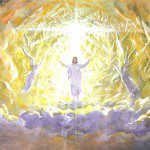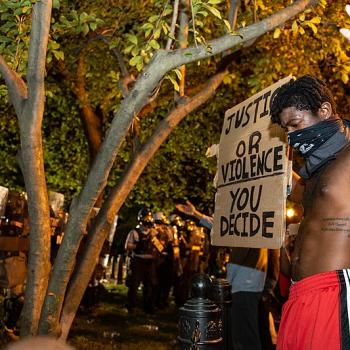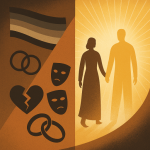
It starts as soon as we can toddle out of our cribs. It rears its ugly head on playdates and in day care and mother’s day out.
By the time we’ve gotten to first grade, “it” is full-blown and set in concrete.
The “it” I’m referring to is the sad human practice of setting aside a member of our group for isolation which turns neatly into group attacks and shunning. Anytime there are more than two people in a group, one of them is going to be the outsider.
When we allow ourselves to give full vent to our Lord of the Flies side, this ugliness rapidly and inexorably becomes bullying and attacking the ones we’ve singled out. There is almost no low to which people will not sink when it comes to group attacks on the hapless outsider.
That, and not lust, is what leads to outrages such as groups of high school jocks, gang raping the mentally challenged girl. It was behind an incident I remember from my own high school years. Several of the the school football players, (why is it so often athletic teammates?) held down a mentally challenged boy and shaved his head in the school hall.
That incident taught me a lot about people, and what it taught me has proven to be ever-true.
I didn’t know what was happening while it was going on. I rounded the corner to go to my journalism class and found the hall completely blocked by a crowd of students. They were yelling and jeering; shoving and jostling.
My journalism teacher, a smallish young woman, was on the periphery, trying to fight her way to the center of the crowd. She was yelling “Stop!”
No one paid attention to her. At one point, one of the jocks reached out and shoved her back. Meanwhile, our school principal and vice principal, both good-sized men, stepped around the corner, saw what was happening, and turned and walked away.
I didn’t know what was going on until the crowd quieted and broke up. Then, I saw the boy, lying on his side on the tile floor, crying like a broken child.
He was mentally challenged. From what I saw, he spent his days in school alone, drifting through his “education,” by being passed on by teachers who just gave him grades. A few weeks before this happened, he had taken to wearing an odd haircut. Nothing really outlandish, just long and, as was his wont, kind of klutzy.
Now, he was lying there crying, with his head shaved, bits of his hair lying on the floor beside him.
It was a huge school. I don’t know this boy. Didn’t know him then. I have no idea where he is now or if he ever got past this assault and the awful humiliation those jocks visited on him. I never saw him again after that day. For all I know, his parents removed him from the school.
They might as well have because it was clear from the first moment that no one except that one hapless and ultimately helpless female teacher was going to come to his rescue. In fact, what happened afterwards was, even though I didn’t know it at the time, a classic of victim blaming/shaming.
No one reproached the letter guys (what we called the school jocks, named for the “letter” on their athletic jackets) for what they had done. The talk around the school, with the single exception of that one journalism teacher who was outraged, was all about how he “deserved” it, how he’d been “asking for it,” by showing up with that hair cut.
It was a lesson that the girls of the school knew well. Those same football players who had shaved the boy’s head lined up outside the cafeteria every day before lunch. The girls of the school had to walk a gauntlet to get to their food.
Letter boys lined both sides of the hall, leaning back and watching the girls go by. There were catcalls and harassments to swallow before we got to our mashed potatoes and jello salad.
A number of the girls complained about this, in fact they complained several times. But those same male principals who turned around and walked away when the jocks were attacking the boy, also turned studiously deaf ears to requests to bring an end to the line up.
That’s what we called it. “The line up.”
Things are no better today. The bullies and jerks of this world still feel free to isolate and attack with impunity. And the rest of us still take a look, turn and walk the other way.
Cowardice in the face of group censure is as strong in the human psyche as the fear of falling. We human beings are not the fastest or the strongest. We don’t have 3 inch claws or fangs jutting down. At the same time, we are big. We can’t be satisfied with a repast of small prey. We’ve got to go after the big stuff.
God made us, from our beginning, reliant on our wits and on one another. The devil does the rest.
The need in each of us to be liked and accepted, to be part of a sheltering group, quickly becomes a keening wail when it is denied. That’s why blaming the victim is such ubiquitous fiction. Because it shelters the group from taking on the group leader, and in far too many instances, the group leader is the bully on the block.
We don’t just find ourselves by accident as part of groups that are run with ruthless disregard for the weak by the biggest and meanest. We tend to actively chose it.
We do this first by following whoever moves. The male psyche in particular is inclined to follow action of any sort. I’ve spent my working life in the company of groups of men and I’ve seen this dynamic play out many times.
We do it second by feeling threatened ourselves when someone else becomes the group goat. We know, whether we will admit it or not, that the ubiquitous “they” who is leading the attacks on this person, can and will turn and attack us if we try to come to their rescue. Besides, we secretly like seeing people get whittled down to size and put in their place. As they shrink, we feel bigger by comparison.
Victim blaming is nothing more nor less than a form of cohesion building within a group. It is a kind of exemplary discipline meted out not so much to the hapless victim as to the group members who line up and join in the victim blaming/shaming. The message is, get with the program or, next time, it will be you.
The Lord of Flies dynamic is the basic dynamic of human groups. It is the single most potent organizing structure we possess: That of uniting against a common enemy. If there is no common enemy, we create one out of the weakest or the easiest to isolate among us.
The internet, with its anonymity, challenges our need to be part of a group. So we form groups around tiny bits of our personalities, such as a single belief or attitude. Then we begin the process of identifying who we can single out and attack as a group activity.
The Vatican recently called internet bullying “a new form of violence.” In that same discussion, internet bullying was defined as “repeated verbal or psychological harassment carried out by an individual or group.” It includes, “mockery, insults, threats, rumors, gossip, disagreeable comments or slander.”
Does that sound familiar? It should, because one group of people who have been singled out for more than their fair share of this stuff is Christians, in particular Roman Catholics.
I could give you quote after quote, headline after headline, in which, if you replaced Catholic with any other group, the public outrage would be over the top. But not us. We are the new people that it’s fun to hate; the new organizing common enemy of quite a number of internet groups.
The question for us — and it is a question that speaks to our survival — is whether or not we will allow the bullies to cut individuals out of our group and then harry them down to the ground. Are we going to join our attackers when they play blame the victim?
Because if we do that, we might as well hang it up. We are salt that has lost its savor. And we are going down.











